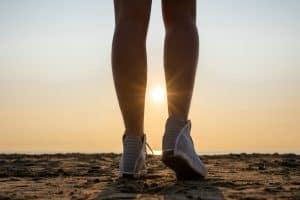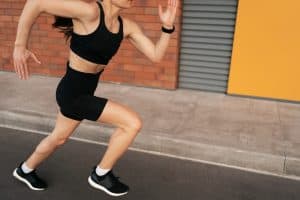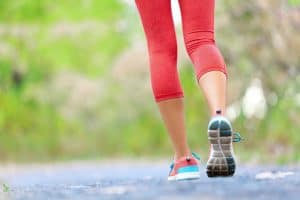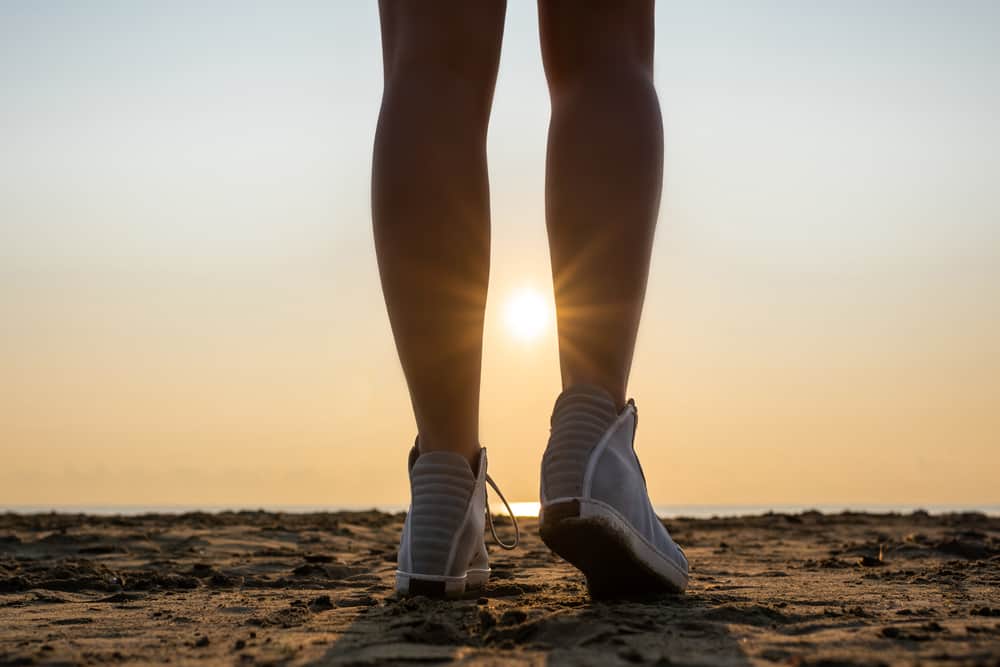It’s not uncommon for people to wonder how a certain workout will affect their body shape. After all, it’s one of the main reasons people exercise in the first place.
When you take up running as a hobby, you might start to wonder what that is going to do to your figure.
So, does running make your legs bigger?
If you look at elite marathon runners, you’ll see lean bodies with skinny legs.
But isn’t that a bit counterintuitive? Shouldn’t exercise help you bulk up leg muscle?
Well, strength training does, but cardio is a whole different story.
In this post, we go over how running affects leg muscles, what factors are in play, and how you can optimize your workout experience.
Does Running Make Your Legs Bigger or Slimmer?
Let’s get started!

Does Running Make Your Legs Bigger?
Running on its own won’t make your legs bigger. In fact, it’s an aerobic exercise that helps burn fat and keeps your whole body slim, not just your legs.
However, to see a significant slimming effect in the lower body, you need to take running seriously, much like professional athletes.
If you only run occasionally, you might notice that your muscles are more toned and defined but not necessarily bulky.
The kind of running that makes your legs bigger has to involve strength workouts like hill sprints or stair climbers.
How Running Makes the Legs Slimmer
It’s a well-known fact that cardio helps you lose weight.
When we say cardio, we mean aerobic activities. Those are the kind of exercises that stimulate the muscles to burn energy in the presence of oxygen.
Although your body has a lot of “fuel” sources, fat is the first to go after depleting a tiny amount of carb storage from your liver.
That’s why running is a great exercise for weight loss.
However, it’s important to note that spot reduction doesn’t exist. You can’t burn fat in only one area by doing cardio.
Instead, your entire body fat content drops. The distribution of this fat content on your body is up to your genes, hormones, and a bunch of other biological factors out of your hands.
Weight Loss vs. Muscle Building
Running is a compound activity that works several muscles in your lower body, including the hamstring, glute, quad, and calf. You might even incorporate your core if you’re doing it right!
Yet, running isn’t considered a replacement for leg day.
First things first, let’s try to understand the process of muscle growth.
When the trauma from intense physical activity meets a certain threshold to the muscles, it activates the “repair mode” by stimulating anabolic satellite cells. This, of course, only happens if you give your body enough building blocks (protein) and time to heal.
The thing with being an avid runner is that you typically don’t do enough strength workouts to activate muscular growth. Plus, you probably rely on carbs way more than proteins.
So, don’t expect any significant muscle building from running alone.
Instead, if you’re already slim, you might even lose muscle mass from intense running since your body is looking for energy to keep going after it burns the fat.
That’s why it’s always recommended to have a bit of protein in your carb-loaded runner’s diet for muscle conservation.
If you do want to grow muscles, you’ll have to incorporate anaerobic strength workouts, eat more protein, and take frequent rest days. It takes a whole lot of planning, but we’ll get to that later!
Factors That Affect a Runner’s Leg Mass

People run for different reasons. Some do it to ward off diseases. Others do it to stay in shape. You might even be after the runner’s high.
Regardless of what your end goals are, it’s helpful to know what factors are in play. This way, you can navigate along your training program to get the best results.
Here are some of the most important factors that influence the impact of a running session on your body shape:
Workout Intensity
While running is cardio, it can still have varying effects depending on how you do it.
Doing long runs at an easy pace is the best way to slim down your thigh and calf if you do it regularly.
On the other hand, sprints lean more towards toning and slightly buffing up your legs.
Additionally, other workouts that you supplement your training program with will impact how your body ends up looking.
Weight lifting is the road to muscle building, while any aerobic activity that gets your heart rate up and going aids weight loss by burning fats.
Diet
What your main nutrition source is like and how much you eat of it will have a significant effect on your weight.
It’s usually a complex balance to maintain, and we’d recommend talking to your physician about the best nutritional route for you.
However, the jest of it is that proteins help bulk you up with the right strength training. Meanwhile, carbs are a runner’s best friend. Fats should be lowered either way.
There’s a bit of a catch, though.
Although running is a cardio activity that burns calories, it can be quite the appetite booster for some people. That’s why you might feel immensely hungry after a run.
To make matters worse, carbohydrates can have an almost addictive side effect, which is very counterproductive if your initial goal is losing weight.
Here, having a strong will comes into play. You have to stick to your meal plans. You can have post-run meals, but avoid binging on fats and junk food after running sessions.
Initial Body Shape
People tend to forget this, but body shape has a lot to do with genetics, from your metabolism to where your body stores fats the most.
It’s estimated that around 70% to 80% of your predisposition to weight gain comes from your genetic makeup.
That’s not to say that exercise is pointless.
Take, for instance, a sedentary lifestyle. You’ll find that it’s bad for you on so many different levels, from cardiovascular health to mood balances.
When you run, do it for the sake of being fit.
You can find some tips here and there that will slightly shift your fat content or muscle mass one way or the other, but keep the mental and physical health benefits your priority.
How to Slim Down Your Legs By Running
If your goal is to slim down your body from the thigh down, you’re in luck!
As we’ve covered, running is an inherently good exercise for weight loss. That is if you can find the right motivation to keep going.
Let’s take a look at some tips that can help you make the most out of your running sessions:
Take Mileage Over Pace Any Given Day
When people think of running for weight loss, they usually push themselves beyond a reasonable pace. That’s sprinting, and you want to avoid it.
Not only does this put them at risk of injuries, but it also doesn’t serve their goal all that much.
To burn fat with cardio over the long run, you need to focus on mileage more than speed. That’s what running endurance is all about.
So, aim for consistent long runs and easy jogging sessions. Start with two miles at the most comfortable pace you can muster, and add a mile at a time.
Endurance doesn’t demand running out of breath. You can lose weight without getting your heart rate over 70% of your peak performance.
Don’t take just our word for it.
That’s what marathon runners do, and look at how skinny they usually are!
Keep Strength Workouts to a Minimum
To avoid bulking out too much, you need to cut out anaerobic exercise and focus on doing aerobic cardio instead.
You don’t have to cut it out completely. It’s still important to work your muscles occasionally to supplement your endurance training.
Hitting the gym for one leg session every week could be enough for runners who only want to conserve, not build leg muscles.
It’s simple enough to tone your legs for running, but it won’t be enough to increase the bulk mass.
Boost Your Training Plan
Going for long, easy runs day in and day out can end up being a bit monotonous and boring, even for passionate runners.
That’s where cross-training comes to the rescue.
Cross-training here refers to supplementing your running program with a few days of different workouts.
There are a bunch of other workouts that can help you shed extra weight. Pick your favorites and alternate between run days and other workouts.
Swimming, jogging, cycling, jumping jacks, or even simple walking could work. As long as you steer clear from repetitive strength exercises.
Pick Balanced Diets for the Win
We can’t stress enough how important it is to have a balanced diet as an athlete. Typically, a runner’s diet leans more towards carbohydrates as the main source of energy.
You’ll also need to cut back on the fat content, but you don’t want to completely cut off protein intake. Otherwise, you risk losing muscle fiber.
Remember your goal here is to preserve your current muscles without bulking them up, not depleting your muscles!
For this nutritional goal, the American College of Sports Medicine recommends aiming for 0.35 grams per pound of bodyweight daily.
Keep in mind that calorie deficit diets usually start on a gap of no more than 500 calories. That means that you only need to burn 500 calories more than your intake.
How to Bulk Up Your Legs By Running

Not everyone wants lean legs. After all, different body shapes have their unique appeal.
Preserving muscle tissue is already a tricky feat since running works to trim any excess body weight.
If you’re a runner who wants to build bigger legs, you have a bit of a bumpy road ahead. Remember how hard muscle conservation was while running? Muscle gain is even harder!
Here are some tips and tricks that can help you navigate through:
Sprint as Much as You Can
Boosting your pace can be exhausting, but it helps you make the most out of your running sessions.
If you still don’t have the endurance to keep going far at a longer pace, keep your sprints short and simple.
You can also insert laps of sprints between easy runs and jogging laps to alternate between different intensity levels.
Just make sure you warm up and cool down properly to avoid injuries!
Spice Up Your Runs
Putting some strength training into your running sessions can help you work those leg muscles and get bigger thighs and calves.
Ideally, you might resort to hill sprints and long jumps on two separate days to supplement your weekly workout routine.
For a quick workout, you can finish up your runs with some pushups and planks, then end with cool-down stretches.
Rely on Proteins
While strength workouts can stimulate muscle growth, it’s no good if your body can’t get the building blocks that it needs.
If you lift weights regularly, don’t drop below a basal intake of 0.8 grams of protein per pound of body weight.
A lower intake won’t only reduce your gain in mass, but it might also leave you at risk for muscle depletion.
Never Skip Leg Day
The most important part of building leg muscles is going for anaerobic strength training days.
Just make sure your leg exercises don’t overlap with days with intense runs.
You’ll also need to do a variety of workouts to hit every muscle group. You don’t want to end up with disproportionate bulking!
Here are some well-balanced exercises that can help you work out your legs:
- Goblet squat
- Weighted calf raises
- Deadlift
- Hip thrust
- Leg press
- Prowler push
- Leg curl
Final Thoughts On Does Running Make Your Legs Bigger or Slimmer?
Next time you hear someone asking: “Does running make your legs bigger?” you can clear that misconception right up.
Running burns fats and works the leg muscles without bulking them up, leading to the iconic marathon runners’ slim but toned legs!
However, there are way too many factors to consider, from how intense you run to what other exercises you do.
To bulk your leg muscles as a runner, you need to supplement your training program with strength exercise, adequate protein intake, and a lot of recovery days.
In the end, you need to keep in mind that genetics and bone structure play a major role in any body shape.

